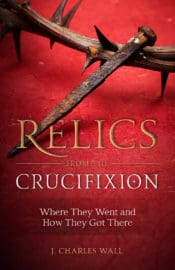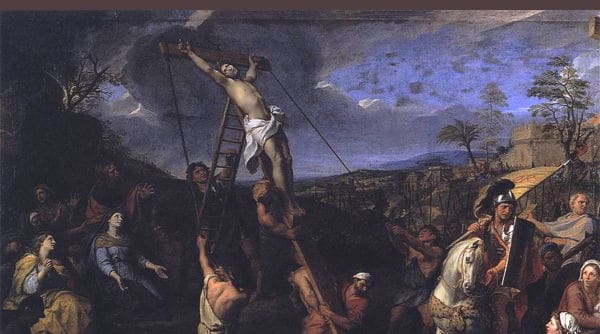When the world rang with the news that the Holy Cross had been discovered, and everyone was asking for details, according to the working of each individual mind, there arose these questions among others:
Of what wood was it made?
Where did it grow?
In which locality budded forth that plant that, when matured, was to become the instrument of torture and the crude deathbed of the Son of God, the Son of Man, and the means of the world’s salvation?
The cursed tree!
The blessed tree!
Not only were these questions asked, but every one was answered! Many were the traditions that sprang up for that purpose, never thought of before the great discovery of St. Helena.
Seth Takes a Branch from the Tree of Knowledge
The widespread legend of the origin of the wood that is found partly related in the apocryphal Gospel of Nicodemus (not later than the third century) and in the Golden Legend is to this effect: when Adam fell sick, he sent his son Seth to the gates of the Garden of Eden to entreat God for some drops of the oil of mercy distilled from the Tree of Life with which to anoint his head. Seth easily found his way to the goal, as no grass had grown over the footprints of Adam and Eve since their expulsion. While Seth prayed at the gate, St. Michael appeared to him, saying, “I am sent unto thee from the Lord; I am appointed to preside over human bodies. I tell thee, Seth, do not pray to God in tears and entreat Him for the oil of mercy wherewith to anoint thy father Adam for the headache; because thou canst not by any means obtain it until the last day and times, namely, till five thousand and five hundred years be past.”
Michael gave him, however, a branch of this tree, which, on the death of Adam, Seth planted on his grave. In after years, the tree flourished and attained a great age. When Balkis, the queen of Abyssinia, came to Solomon, she worshiped this tree, “for,” said she, “thereon should the Savior of the world be hanged, and that from that time the Kingdom of the Jews should cease.” On hearing this, Solomon commanded that the tree should be cut down and buried in a certain place in Jerusalem, where the pool of Bethzatha was dug, and the guardian angel of the mysterious tree troubled the waters of the pool at certain seasons, and those who first dipped into it were cured of their ailments (see John 5:1-9).
As the time of the Passion of the Savior approached, the wood floated to the surface of the pool, and of that timber was made the upright part of the Cross. The crossbar was made of cypress, the piece to rest the feet upon was of palm, and the inscription was written on a piece of olive.
Planting the Seeds for the Wood of the Cross
Another common form of the same legend makes the archangel Michael, who refused Seth the oil of mercy, give Seth three seeds from the Tree of Knowledge to be placed beneath the tongue of Adam when he was buried, promising him that from those seeds should grow a tree that would bear fruit whereby Adam should be saved and live again. From the three seeds sprang a trinity of trees of three separate woods, cedar, cypress, and pine, although united in one trunk. From this tree Moses cut his rod. It was transplanted by David to the borders of a pool near Jerusalem, and beneath its branches he composed his psalms.
Solomon had it cut down to form a column in his Temple, but being too short, it was rejected and cast over a stream to serve as a bridge. The queen of Sheba, when visiting Solomon, refused to pass over on that tree, declaring that it would one day occasion the destruction of the Hebrews. The king ordered that it should be removed and buried. This was done near the pool of Bethesda, at which time the virtues of the wood were immediately communicated to the waters. After the condemnation of Christ, it was found floating on the surface of the pool and the Jews took it for the main beam of the Cross.
Theories about the Wood of the Cross
The prevailing idea was that the Cross was formed of three or more woods; either that the various parts were made, each from one of the three in that trinity springing from one root or, an idea not consistently followed, that the three woods were amalgamated, forming one trunk, out of which the upright beam was fashioned, thus containing in one beam the qualities of the three plants. And again, this peculiar growth was produced from three seeds containing three properties, although the fruit of one and the same tree.
It is curious to see how the same traditions will last through ages, taken from or added to, until in the last edition the earliest form is unrecognizable. Even Mandeville (fourteenth century) must have had very simple faith in the tradition — by his time much confused — to speak in his travels of a tree that was then lying as a bridge over the Kedron “of which the Cross was made.”The prevailing idea was that the Cross was formed of three or more woods; either that the various parts were made, each from one of the three in that trinity springing from one root or, an idea not consistently followed, that the three woods were amalgamated, forming one trunk, out of which the upright beam was fashioned, thus containing in one beam the qualities of the three plants. And again, this peculiar growth was produced from three seeds containing three properties, although the fruit of one and the same tree.
The Venerable Bede (c. 673-735) and John Cantacuzenus (c. 1292-1383) both record the idea that the Cross was composed of four kinds of wood: cypress, cedar, pine, and box.
Innocent says the upright was of one wood, the transverse beam of another, the title of a third, and that the feet were supported on a projecting step made of a fourth wood.
In England a notion existed that the wood was mistletoe, then a tree, but that ever since the Crucifixion it has been but a parasite.
The aspen leaf was said to tremble because the Cross was of that wood.
In some parts of England the elder tree is supposed to have been the wood of the Cross, and to the present day some reverend peasants carefully look through their faggots before burning them for fear there should be any of this wood among them.
Another common idea is that the main beam of the Cross was of cedar, the transverse of cypress, the inscription was carved on a piece of olive, and the footrest was of palm.
Some people who meditate on the fabulous combine the woods of the fir pine and box in the Holy Cross. An old legend makes out that the Cross was made of “Palm of Victory,” “Cedar of Incorruption,” and “Olive for Royal and Priestly Unction.” And in a Latin verse we are told:
The foot of the Cross is Cedar, The Palm holds back the hands, Th’ tall Cypress holds the body, The Olive in joy is inscribed.
Lipsius (d. 1606), the most learned writer on the subject, thinks that the Cross was probably of oak, a wood abounding in Palestine, easily procured and strong. The relics he had seen he thought to be of that wood.
It is pronounced to have been of oak by A. F. Angelo Rocca Camerte in his book De Particula ex Pretioso et Vivivico Ligno Sacratissimae Crucis (Rome, 1609), in which he gives an account of a fragment in the Apostolic Treasury. This is supposed to be the same fragment for which Pope Leo the Great (c. 400-461) thanks Juvenal (d. 458), bishop of Jerusalem, in one of his letters, circa 450.
Curzon says that all the very ancient relics of the Cross that he had seen were of the same wood, which had a peculiar, half-petrified appearance. In his possession were two relics, said to be of the True Cross, the older enclosed in a shrine of the late thirteenth century; the other, in a modern setting, was of a different wood.
So much for the divided opinions concerning the wood of the Holy Cross, which after all, with the multiplicity of conjectures, leaves the question unsolved. The folklore of Europe teems with them; certain veins of legends are found to run through countries where the same traditions predominate.
The fragments this writer has seen are of a rich burnt-umber color; the grain, a little lighter, stands somewhat in relief from the decaying fiber around, but the substance of them is too far perished to decide on the kind of wood they originally were.
Where did the wood of the Cross grow? King David is said to have transplanted it from Lebanon to a spot near Jerusalem. “To the west of Jerusalem is a fair church where the tree of the Cross grew,” says Sir John Mandeville around 1360.
Henry Maundrell (1665-1701), in his description of a Greek convent that he visited about half an hour’s distance from Jerusalem, says: “That which most deserves to be noted in the convent is the reason of its name and foundation. It is because there is the earth that nourished the root, that bore the tree, that yielded the timber, that made the Cross. Under the high altar you are shown a hole in the ground where the stump of the tree stood.”
A mile or two west of Jerusalem, in a valley among the hills, is the Greek monastery of the Holy Cross, which is the convent referred to by these two travelers. The foundation dates from a period not long subsequent to the discovery by St. Helena. The buildings now standing are of a great age.
+
This article is adapted from a chapter in Relics from the Crucifixion by J. Charles Wall which  is available from Sophia Institute Press.
is available from Sophia Institute Press.
Art for this post on the beauty of the devout life: Cover of Relics from the Crucifixion used with permission.
For further reading on the Holy Cross, click HERE.





